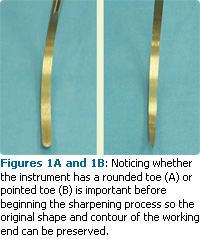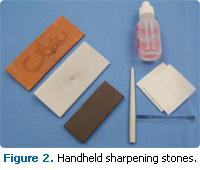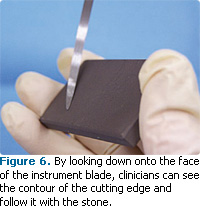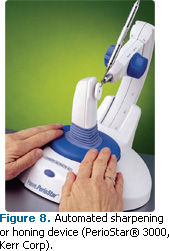
Back to Basics
Refresh your skills with this review of sharpening fundamentals.
“Working smarter, not harder” is an adage that definitely pertains to the maintenance of sharp scaling instruments. If dental hygienists can master instrument sharpening, their working life will be significantly easier.

The most important goal in maintaining instrument sharpness is to preserve the original shape and contour (Figure 1A and Figure 1B). Before beginning sharpening, ask two questions:
1. Are the cutting edges straight or curved from the heel to the toe of the instrument?
2. Is the toe pointed or rounded?
Keeping this information in mind will reduce the risk of instrument damage during the sharpening process.
MANUAL METHOD
Instruments should be sharpened at the first sign of dullness. A sharpening work station incorporated into the dental hygiene treatment room allows clinicians to react quickly when instruments become dull. Several sets of sterile stones and test rods should be available so sharpening can be conducted quickly prior to seating patients and during treatment when an instrument may become noticeably dull (Figures 2-4).

Manual sharpening is an effective method for preserving instrument shape and contour. Stone selection should be based on the dullness of the instrument. Fine to medium stones are necessary for routine sharpening and a coarse stone is best for extremely dull cutting edges. A two-sided abrasive surface (medium on one side and fine on the other) is an efficient option. While some stones must be treated with water or oil, many do not require lubrication.
The stationary instrument/moving stone technique relies on the clock face for instrument positioning. While the instrument is held in the nondominant hand with the face of the blade parallel to the floor, the stone is held in the dominant hand and initially placed at the 12 o’clock position and then moved to 1 o’clock or 11 o’clock to activate the sharpening stroke (Figure 5). By looking down onto the face of the instrument blade, the dental hygienist can visually see the contour of the cutting edge and closely follow it with the stone (Figure 6).

Two tools are available to help dental hygienists with manual sharpening: A selfinstructional DVD and manual It’s About Time (Hu-Friedy Mfg Co Inc); and Sharpening Essentials DVD, workbook, and disposable sharpening guide (Edgemate Inc). These programs provide a video that demonstrates the technique for sharpening curets and scalers along with a step-by-step workbook to improve sharpening skills. A sharpening stone with two grades of coarseness can be purchased with both study guides.
Manufacturers are also producing instruments that stay sharper longer. Newer stainless steel alloys and heat treatment processes create a more durable edge that can maintain sharpness for 3 months to 4 months (XP Technology by American Eagle Instruments Inc and EverEdge® Technology by Hu-Friedy Mfg Co Inc). Newer diamond-coated instruments never need sharpening, but they are only available in a few designs and are expensive.
 |
 |
AUTOMATIC DEVICES

- Does it sharpen the lateral sides of the blade or the face? Removing metal from the lateral side of the working end maintains the overall strength of the instrument, which, in turn, prolongs its service life.1
- Can instruments with curved blades be moved in a pendulum-like motion across the stone to maintain the curvature? Maintaining the original shape of the instrument is just as important as having a sharp cutting edge.
- Are the instructions easy to understand? The directions must be followed carefully to avoid altering the design of scaling instruments.
A honing machine is one example of an automated sharpening device (Figure 7-Figure 8). It can be a bench-type or smaller battery-operated piece of equipment that follows the principles of instrument preservation. Specially designed honing disks are mounted on top of the machine, and rotate up to 7,000 rpm. These devices will remove metal from either the face or lateral sides of the blade as the clinician controls the pressure. If the metal is being removed from the lateral sides of the cutting edge, the dental hygienist must be able to maintain the pendulum-like motion from heel to toe to preserve the gentle curve of the Gracey cutting edge or the flame-shaped cutting edge of some sickles. In addition, clinicians must be confident in instrument positioning and application of pressure.

Mandrel-mounted stones are used with slow-speed handpieces. The rotating stone should be larger than the diameter of the instrument blade that is being sharpened. While the handpiece is activated at a slow speed, the stone is passed over the face of the blade to sharpen both cutting edges at once. This method requires stabilization of the instrument in one hand and the handpiece in the other. Again, dental hygienists must be careful in applying pressure because it is easy to remove too much of the blade’s face, rendering the instrument useless.
SHARPENING SERVICES
Professional services are available where clinicians mail their dull instruments to a company for sharpening. These services typically charge a fee per working end, and may require a handling and/or shipping fee. The instruments may require packaging that proves sterility and insurance to protect against loss or damage during the shipping process. These services will inspect the instruments for excessive wear and note those that need replacement. They also save time by eliminating the need for dental hygienists to maintain their equipment, which creates more time for patient care. Because the instruments are not available for a few days (depending on the location of the service), dental hygienists need to schedule sharpening around vacations or holidays or maintain a sufficient armamentarium of instruments for use when sharpening is scheduled.
THE RETIP QUESTION

The debate continues over whether to retip instruments. There are valid arguments on both sides of the controversy. Retipping instruments is economical but safety and quality control are concerns. Clinicians need to understand how instruments are manufactured in order to make an informed decision about retipping. All manufacturers use proprietary materials and tools to create instruments, which means that one company’s tool may not be suitable for retipping by another manufacturer. Once the instrument is altered, it is considered remanufactured and the original warranty is void.2
The high heat needed to remove and replace the working end can create microcracks in the collar of the handle—weakening it—while also creating the possibility for microleakage of bacteria into the handle.3 The United States Food and Drug Administration (FDA) requires that all retipped instruments be stamped “retipped” or “refurbished.” FDA guidelines warn that retipped instruments have been altered and may compromise performance. The FDA also states that the original manufacturer is absolved from all liability during their subsequent use.
CONCLUSION
There are a variety of methods for maintaining sharp instruments that, in turn, will create a more productive working environment. Dental hygienists should thoroughly investigate all avenues of instrument sharpening and choose the method that works best for their practice.
REFERENCES
- Nield-Gehrig JS. Fundamentals of Periodontal Instrumentation and Advanced Root Instrumentation. 5th ed. Philadelphia: Lippincott Williams & Wilkins; 2000.
- Burns S, Bendit L. Proper instrument care, the “myth” of retipping. Journal of Practical Hygiene. 2006;15(3):27.
- Cooper M. Is it time to purchase new tools or retip the old ones? Contemporary Oral Hygiene. 2002;2(3):10-11.
From Dimensions of Dental Hygiene. September 2011; 9(9): 40-42.

